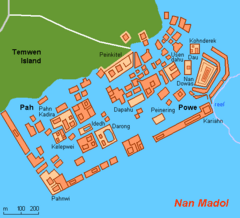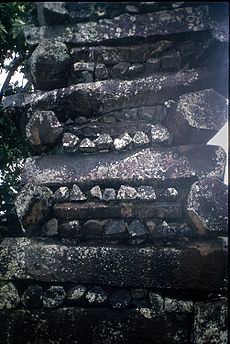Nan Madol facts for kids
Quick facts for kids Nan Madol |
|
|---|---|

Nan Madol
|
|
| Location | Temwen Island, Federated States of Micronesia |
| Official name: Nan Madol: Ceremonial Centre of Eastern Micronesia | |
| Type | Cultural |
| Criteria | i, iii, iv, vi |
| Designated | 2016 (40th session) |
| Reference no. | 1503 |
| Region | Asia and the Pacific |
| Designated | 19 December 1974 |
| Reference no. | 74002226 |
| Designated | 16 September 1985 |
| Lua error in Module:Location_map at line 420: attempt to index field 'wikibase' (a nil value). | |
Nan Madol is an amazing ancient city built on the island of Pohnpei in the Federated States of Micronesia. It's located in the western Pacific Ocean. This city was once the capital of the Saudeleur Dynasty, a powerful ruling family, until about the year 1628.
What makes Nan Madol so special is how it was built. It's a city made of many small artificial islands. These islands are connected by a network of canals, like a maze of waterways. The main part of the city has strong stone walls. It stretches about 1.5 kilometers long and 0.5 kilometers wide. Inside, there are nearly 100 artificial islets, which are platforms made of stone and coral. Tidal canals flow between them.
The name Nan Madol means "within the intervals," referring to the canals that cross the ruins. Some people call it the "Venice of the Pacific" because of its canals. It's also known as one of the world's great archaeological mysteries. Some even call it the "eighth wonder of the world."
Contents
History of Nan Madol
Nan Madol was the main center for ceremonies and government for the Saudeleur Dynasty. This dynasty ruled over Pohnpei's people, who numbered around 25,000, until about 1628. People started living in this area as early as the first or second century AD. By the 8th or 9th century, they began building the artificial islands. The impressive stone buildings, called megalithic architecture, started to appear between 1180 and 1200 AD.
How Nan Madol Was Built
Not much is known for sure about how these huge stone structures were built. A local legend says that two sorcerer brothers, Olisihpa and Olosohpa, built Nan Madol. They came from a mythical place called Western Katau. The brothers were looking for a place to build an altar to worship the god of agriculture.
After a few tries, they successfully built an altar near Temwen Island. The legend says these brothers used a flying dragon to lift the giant stones into place! When Olisihpa grew old and died, Olosohpa became the first Saudeleur ruler. He married a local woman, and their family ruled for many generations.
The End of the Saudeleur Dynasty
At first, the Saudeleur rulers were kind. But later rulers demanded more and more from their people. Their rule ended when a warrior named Isokelekel invaded. Isokelekel also lived at Nan Madol for a while. However, the rulers who came after him eventually left the city.
In 1874, a Polish explorer named John Stanislaw Kubary created the first detailed descriptions of Nan Madol.
Purpose and Features of the City
Nan Madol was a special place for the ruling class and priests. It was where the nobles lived and where important ceremonies took place. The population probably didn't go over 1,000 people. Many residents were chiefs, but most were common people.
One reason Nan Madol was built was to help the Saudeleur chiefs control their rivals. By making them live in the city, the chiefs could keep an eye on them. This was easier than if rivals stayed in their home districts.
Different Areas of Nan Madol
The northeastern part of Nan Madol is called Madol Powe. This area has 58 islets and was used for burial ceremonies. Most of these islets were once home to priests. Some islets had special uses:
- Dapahu was for building canoes.
- Peinering was for making coconut oil.
There are high walls around tombs on islets like Peinkitel, Karian, and Lemenkou. The most important tomb is on the royal burial islet of Nandauwas. Here, walls that are 5.5 to 7.5 meters high surround a central tomb. This was built for the very first Saudeleur ruler.
Daily Life in Nan Madol
Life in Nan Madol had its challenges. There was no fresh water or food on the artificial islands. Water had to be collected, and food had to be grown inland on Pohnpei. During the Saudeleur rule, people brought essential food and water to the city by boat. The rulers received their food at specific islets, first Peiniot, then Usennamw.
Around 1628, when Isokelekel took over from the Saudeleurs, the new rulers, called Nahnmwarkis, also lived at Nan Madol. But they had to find their own water and grow their own food. This is believed to be one reason why they eventually left Nan Madol and moved back to their own districts. Another idea is that the population of Pohnpei might have dropped sharply, leading to the city being abandoned.
Archaeology of Nan Madol
Today, Nan Madol is an important archaeological site. It covers more than 18 square kilometers. It includes the stone buildings on a coral reef flat along the shore of Temwen Island. There are also many other artificial islets and the nearby Pohnpei coastline. The main part of the site, with its stone walls, is about 1.5 by 0.5 kilometers. It contains nearly 100 artificial islets made of stone and coral, with tidal canals flowing between them.
Scientists use carbon dating to figure out how old things are. This method shows that the building of large stone structures at Nan Madol began around 1180 AD. The huge basalt stones used for building were brought from a volcanic rock formation on the other side of Pohnpei. The earliest signs of people living on Pohnpei are from around 1 AD, with human activity starting around 80–200 AD.
In 1985, the ruins of Nan Madol were named a National Historical Landmark. This means they are a very important historical place.
Theories About Lost Continents
Some people have suggested that Nan Madol might be connected to "lost continents" like Lemuria or Mu. For example, writer James Churchward believed Nan Madol was part of the lost continent of Mu.
Other theories include:
- Writer Bill S. Ballinger thought the city was built by Greek sailors around 300 BC.
- Author David Hatcher Childress also believes Nan Madol is linked to the lost continent of Lemuria.
- Some suggest that building Nan Madol with such heavy stones and precise methods would have needed advanced technology. Since no such society is known in history, they think it must have been destroyed by a major event.
These are just theories, and scientists continue to study Nan Madol to learn more about its true history.
Nan Madol in Pop Culture
Nan Madol has inspired many stories and works of art.
Television
- The TV show Destination Truth featured Nan Madol, suggesting the ruins are haunted.
Literature
- The ruins were the setting for a lost race story by A. Merritt called The Moon Pool (1918). In the book, the islands are called Nan-Tauach and the ruins are Nan-Matal.
- The novel Deep Fathom (2001) by James Rollins uses Nan Madol and its history as part of its story.
- In the comic book Nameless by Grant Morrison and Chris Burnham, Nan Madol is where the mythical Dream Key of Nan Samwohl is found.
Music
- Nan Madol (1974) is an album by Edward Vesala.
- "Nan Ma Dol" is a song by the band Endura from their 1996 album Liber Leviathan.
- "Ruins of Nan Madol" (2014) is a song by audiomachine.
Video Games
- Nan Madol appears in the game Civilization VI as a Cultural city-state. If a player becomes its suzerain (a powerful ally), they get extra Culture points for districts built near the coast.
See also
 In Spanish: Nan Madol para niños
In Spanish: Nan Madol para niños




